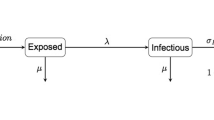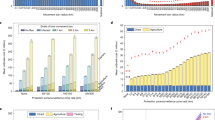Abstract
Arising from: M. J. Tildesley et al. Nature 440, 83–86 (2006)10.1038/nature04324; Tildesley et al. reply
When foot-and-mouth disease struck the United Kingdom in 2001, the traditional 'stamping out' policy of 1967–68 was supplemented by the pre-emptive culling of animals in premises contiguous to infected premises. A model proposed by Tildesley et al.1 indicates that the introduction of vaccination should at least halve the number of premises that would need to be subjected to culling in the event of another outbreak. We contest, however, that the overlapping confidence intervals of the outputs of their model, and the inconsistency of their results compared with those from previous models, call into question the model's value as a decision tool, while adding little to the recognized tenet of ring vaccination.
Similar content being viewed by others
Main
Foot-and-mouth disease occurred regularly in the United Kingdom over the first two-thirds of the twentieth century2. As a result, a 'stamping out' policy was developed that was based on movement restrictions, enforcement of biosecurity, rapid slaughter of animals from infected premises, and tracing and slaughter of dangerous contacts. A disease-free period of more than 30 years followed the epidemic of 1967–68. When the disease returned in 2001, this 'stamping out' policy was augmented by pre-emptive culling in premises contiguous to infected premises; vaccination was not used.
Tildesley et al.1 model 'reactive' vaccination as an alternative to pre-emptive culling on contiguous premises and find that this strategy would at least halve the number of premises for culling. They explore different strategies and conclude that the impact of an epidemic can be restricted most effectively by using reactive ring vaccination, prioritizing farms closest to infected premises. The authors claim that this technique would be more effective than the prioritization of high-risk farms. They also conclude that the addition of culling in contiguous premises is not advantageous when vaccination is practised. However, the overlapping confidence intervals of the parameters associated with the impact of the epidemic under different strategies (Table 2 of ref. 1) indicate that the model cannot offer a clear choice between different scenarios, making its value as a decision tool questionable.
The value of this modelling approach in decision support is further undermined because the conclusions of previous papers based on the same model3,4 are inconsistent with those of Tildesley et al.1. For example, Keeling et al.3 showed that ring vaccination of cattle would reduce the total cull by only about 15%, and that removing culling in contiguous premises from a control strategy that includes ring vaccination would have doubled the total cull; Keeling et al.4 also pointed out that, although ring vaccination generates some benefit, even 10-km rings reduce the size of the epidemic by only about 20%, and that “vaccinating the nearest farms [to infected premises] would be futile”, suggesting that reactive vaccination should be targeted to farms that are predicted to contribute most to future spatial transmission of disease.
The model used by the authors, here1 and previously3,4, is parameterized in such a way as to favour disease-control methods (culling, vaccination or both) that are pre-emptive and localized5. Farms are assumed to become instantly and maximally infectious four days before the simulated infection is reported. The spatial simulation of disease spread in the models is based on spread-tracing information, which the authors themselves previously recognized3 as likely to be biased towards overestimating the amount of short-distance spread of disease. The model still needs to be validated against data not used in its construction6. Without this validation, it remains an untested hypothesis that has produced inconsistent and imprecise conclusions about vaccination policy, and therefore adds little, if anything, to the already well established principle of ring vaccination7.
References
Tildesley, M. J. et al. Nature 440, 83–86 (2006).
HMSO Report of the Committee of Enquiry on Foot-and-Mouth Disease 1968 Vols 1, 2 (Her Majesty's Stationery Office, London, 1969).
Keeling, M. J. et al. Science 294, 813–817 (2001).
Keeling, M. J., Woolhouse, M. E. J., May, R. M., Davies, G. & Grenfell, B. T. Nature 421, 136–142 (2003).
Kitching, R. P., Thrusfield, M. V. & Taylor, N. M. Rev. Sci. Tech. 25, 293–311 (2006).
Spedding, C. R. W. An Introduction to Agricultural Systems 2nd edn (Elsevier Applied Science, London, 1988).
Donaldson, A. I. & Doel, T. R. Vet. Rec. 131, 114–120 (1992).
Author information
Authors and Affiliations
Corresponding author
Ethics declarations
Competing interests
The authors declare no competing financial interests.
Rights and permissions
About this article
Cite this article
Kitching, R., Taylor, N. & Thrusfield, M. Vaccination strategies for foot-and-mouth disease. Nature 445, E12 (2007). https://doi.org/10.1038/nature05604
Published:
Issue Date:
DOI: https://doi.org/10.1038/nature05604
This article is cited by
Comments
By submitting a comment you agree to abide by our Terms and Community Guidelines. If you find something abusive or that does not comply with our terms or guidelines please flag it as inappropriate.



